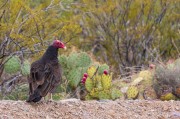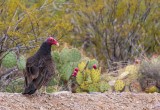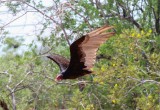
The vultures have landed! The Arizona-Sonora Desert Museum's new Vulture Culture exhibit opens next weekend! Join the celebration with temporary tattoos and face-painting for the kids and cake for everyone (while supplies last). Two turkey vultures and a black vulture committee* are the residents of one of the most innovative and creative exhibits ever developed by the Museum. It's a must-see!!! (*a group of vultures is called a committee, venue or volt)
Tucson, AZ, December 11, 2015 (Newswire.com) - The Arizona-Sonora Desert Museum is celebrating the opening of one of its most ingenious and playful new exhibits on Saturday, December 19, 2015. Vulture Culture’s opening weekend activities (from 10:00 a.m. to 2:00 p.m. on December 19 & 20) include face-painting and removable tattoos for the kids and cake for all (while it lasts). Jonathan Hanson, author of ASDM Press’ book “Victor, the Reluctant Vulture,” will autograph his book about an adolescent’s search for self-worth. A vulture coloring book is also a featured item.
One of the most imaginative exhibits at the Desert Museum, humor is key to educating guests about vulture behaviors that humans consider distasteful—urinating on their legs and vomiting. These normal vulture behaviors have very specific and important roles in the bird’s everyday life.
This exhibit challenged our staff to create innovative methods for educating guests about the seemingly gross habits of the vulture. The result is a fun, interactive exhibit that will thoroughly delight children and adults.
Craig Ivanyi, Executive Director
“This exhibit challenged our staff to create innovative methods for educating guests about the seemingly gross habits of the vulture,” says Craig Ivanyi, executive director of the Desert Museum. “The result is a fun, interactive exhibit that will thoroughly delight children and adults.”
Vulture reproductions around the exhibit encourage visitors to compare their outstretched arms with the wingspan of a vulture—and to experience being a vulture through the eyes of one.
Several castings of Sonoran Desert plants and animals play both functional and animal enrichment roles in the exhibit. Twenty-foot replicas of Palmer Agaves support the Invisinet enclosing the exhibit. And that javelina the vultures are eating from? It’s a casting with their food bowl slipped inside. The bowl will frequently be moved around the exhibit.
Vultures play a vital role in the ecosystem by acting as nature’s sanitation engineers. Traits that help them in their waste disposal role include the familiar bald head that keeps rotting flesh from soiling their feathers. Because vultures are at the end of the food chain, scientists study them to monitor the health of the environment.
The exhibit’s two turkey vultures are a bonded pair that have been together for more than 15 years and have produced at least three clutches of chicks together. The black vulture is a rescue that was rehabilitated at the Audubon Zoo in New Orleans before joining the Desert Museum’s group, or in vulture speak, “committee.”
Focused on the preservation of the Sonoran Desert, the Arizona-Sonora Desert Museum will turn your idea of a museum inside out. Nestled on 98-acres in the Sonoran Desert west of Tucson, a two mile walking trail features 230 native animal species, botanical gardens, an art gallery, an aquarium, educational activities, one of the world’s most comprehensive regional mineral collections and more. Ongoing conservation and research programs enhance everything we do. Open every day 8:30 a.m. to 5 p.m. at 2021 N. Kinney Rd., Tucson AZ 85743 U.S.A. · 520.883.2702 · Plan your visit at www.desertmuseum.org.
*******************300dpi images available**********************
Contact: Yika Riley-Smith: yika@desertmuseum.org/520-323-3073 or
Betsy Warner: bwarner@desertmuseum.org/520-3070
Share:


